Tropical Biology
Scouting Trip Report - Dominican Republic June 8-28, 2015
Contents
Las Terrenas, Samana Peninisula
Hispaniolan Parakeet (Psittacara chloroptera) Santo Domingo, Dominican Republic 28 June 2015
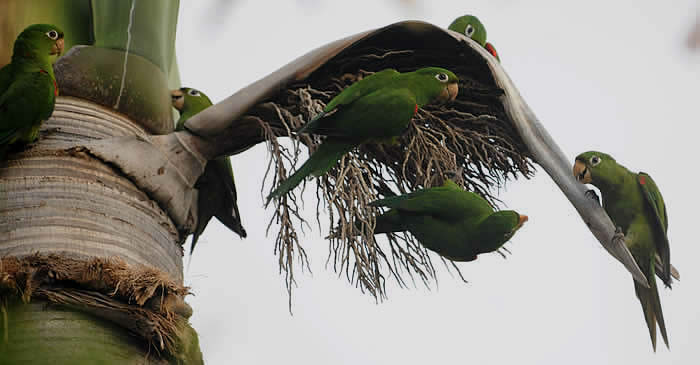
© 2015 Callyn Yorke
Our scheduled 90-minute layover in Newark, NJ was evidently part of United Airlines unadvertised fly-run-fly triathalon. Minutes before our flight from LAX to Newark touched down, the connecting flight to Santo Domingo (UA1470) had begun boarding. Out of breath from a sprint through the crowded terminal, we made it onto our plane just in time to claim the last two seats. Only one more minor annoyance: NO OVERHEAD STORAGE SPACE. Not unexpectedly, this fully-booked flight to the Dominican Republic resembled a well-fed Haitian refugee camp -- excess carry-on baggage was crammed into every available and unavailable space. Almost the same situation occurred for us on the return flight from Santo Domingo. The difference was that it was a much lengthier run to the boarding gate to discover our connecting flight to LA (UA1941) had been delayed more than one hour. Thankfully, United Airlines skies were friendlier than their ground operations.
Ordinarily, all of this Third-World airline drama (mostly while still in the States) wouldn't have bothered us much. We had learned from previous international excursions to expect flight delays, jack-in-the-box surprises at security checkpoints, sleep-deprived flight attendants, underpaid pilots, occasional lost luggage, etc.. What really bothered me was the questionable choice I had made when purchasing our electronic tickets. A premier-class upgrade! My reasoning: Okay, if we are going down with United Airlines, at least it will be with some measure of dignity.
And the lofty attitude of one of the first-class attendants on the Newark-Santo Domingo flight definitely took us down a couple of notches. With a cigar, he could have passed for Fidel Castro, circa 1962. Whatever he actually said was unimportant. Here's what I got: Peasant, we are running late... just find a storage compartment in the economy section, sit down and buckle-up. Certainly, this flight attendant must have realized that doing such would mean that, since we were comfortably seated in row one, we would be the last ones off the plane in Santo Domingo, having to wait for a single-file stampede of passengers to clear the isles so that we could get to the overhead bins fifteen rows behind us. Merissa, who hates flying, gave me a painfully concerned glance. We wondered if this little scene might be the prologue to Mario Vargas Llosa's La Fiesta del Chivo (2000). Roughly translated: Road-killed Goat Feast.
Once airborne, the UA skies became friendly and calm once again. The recent connection and boarding hassles were miles behind us. Our seats were wide and cushy as a livingroom recliner. The food and service, excellent; atmospheric turbulence, unexplained screams, groans and flatulence, gradually subsided. We settled into our reading material.
For me, one of the pleasures of Third-World travel is the incredibly lively, informative and patently optimistic literature of Lonely Planet guidebooks. In fact, without their help, we would have doubtless wasted much time and money. A week before leaving the States, I began skimming the sixth edition (2014) of the Lonely Planet guide to the Dominican Republic. Seemingly too many great choices were available for exploring the natural history, transportation, food and lodging options mentioned in the guidebook. I was skeptical and dug a little deeper. Finally, after reviewing Trip Advisor, we chose to arrive in DR with only a three-night reservation at El Beaterio - a nunnery converted to a rustic hostel, located in the historic Colonial District of Santo Domingo. The rest of our three-week visit had yet to be planned. That was about normal for us.
June 8-11, 2015
Historic Santo Domingo is a bit of an understatement. The LP guidebook claimed that Santo Domingo is the oldest city in the New World. Possibly so. I suppose there is a distinction between settlement and city. I'm sure a few descendants of the nearly extinct Tainos, who were all but wiped out by European guns, greed and viral diseases, would have some rectifying comments in that regard. No doubt Santo Domingo probably has more continuously occupied old buildings than anywhere else outside of Europe and Asia. Natural history is my specialty of course, but this 500-year old city is fascinating on too many levels to ignore.
DR history is complex, colorful and, until recently (1990's), dominated by a ghoulish parade of self-serving dictators. Even before Dominicans won their independence from Spain, Europeans had left their claw marks on Santo Domingo. For example, two brothers, Christopher and Bartholomew Columbus, were eventually returned to Europe in chains, following their botched attempts to govern Hispaniola. Then, aiming to add financial insult to collateral damage, England's celebrated pirate, Sir Francis Drake, sacked the city, ripped off most of the priceless church decorations, and probably sent the El Beaterio nuns running for their chastity. Other pirates of the Caribbean fared less well than Drake. Captain William Kidd was eventually caught and hanged in London in 1699 for piracy, notwithstanding he, like Drake, was acting under the authority of the British navy. Afterwards, it seems reasonable to assume there was no more kidding around amongst British sailors.
A small theatre around the corner from the El Beaterio presented a short historical film loop. It was always closed when we passed by, so we learned nothing. Nevermind. History, unlike the Natural Sciences, is based on about ten-percent documented fact and ninety-percent conjecture. That's why historical novels usually outsell history texts and may earn the creative writer (e.g. Mario Llosa) a Nobel Prize in literature. Folks only want a good story; truth or some fraction thereof is optional. We already had enough facts, e.g. old buildings (mostly renovated) with plaques giving relevant names and dates. Within a few of hours of walking through the Colonial District, we began to get a feel for the city and its inhabitants.
Santo Domingo in particular and DR in general, have a distinctive, collective personality, though nothing like the light-hearted, easy going Jamaica. We struggled to find the right adjective. Charming definitely didn't fit. Merissa and I agreed that the commonest expression on the faces of Santo Domingoans was a combination of indifference and disgust. Resentful - yes, that was the best word for it. Whites were the haves, Blacks the have-nots. We could scarcely take five steps on the street without being approached by someone desperately trying to sell us something. My knee-jerk response, like a idiot, was, no habla, repeated as many times as necessary. It was an obvious lie but efficient as emptying an entire spray can of OFF on a single mosquito. Never underestimate the power of adult illiteracy, which is changing the world one smart-phone at a time.
Surprisingly, there was little change in any street vendor's facial expression. All of them appeared to have studied at the same drama academy. Even when we purchased items, whether an overpriced horse and carriage tour, souvenirs or mouthwash, it was the same dissatisfied, ungrateful, pissed-off countenance. Clearly, there was a foundation for this resentment deep beneath the surface of everyday dealings with tourists.
The bustling daily routine of Santo Domingo conceals a painfully turbulent history of colonial occupation, followed by domestic corruption and violence. We are talking repeated bouts of national genocide and other unspeakable government-sponsored atrocities. Rafael Trujillo's brutal dictatorship of DR (1930-1961) is a case in point. Tens of thousands of islanders (mostly Haitians and DR dissidents) were tortured and murdered under his command. These tragic events were commemorated in Llosa's unforgettable novel, La Fiesta del Chivo. Incredibly (unless you watched TV documentaries about Central America in the 70's), not only did the US State Department know about the Trujillo atrocities, they financially backed his regime. In one of more egregious examples of misguided foreign policy, the United States continued supporting the Trujillo dictatorship, presumably because Trujillo was a progressive capitalist, in sharp contrast with his retrograde communist neighbor, Fidel Castro. Eventually, someone realized the terrible mistake and sent CIA-supplied assasins to abruptly end Trujillo's reign of terror in May of 1961.
Front Cover (First Edition) La Fiesta del Chivo
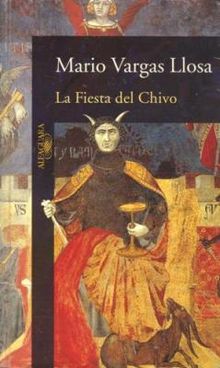
© 2000 Mario Vargas Llosa
Colonial imperialism and ruthless dictatorships are embedded in the Hispaniolan cultures, if not their genes. Western White folks haven't been graciously accepted or entirely trusted on the island since Christopher Columbus kidnapped a dozen Tainos to show off in Europe. In fact, La Navidad, the first European settlement in present-day Haiti, was burned to the ground by the natives in reprisal for the kidnapping. The relocated township in northern DR, La Isabella, was subsequently abandoned due to an unidentified disease that probably decimated the native workers. The capital was finally moved to Santo Domingo where international trade continues to flourish. Western tourists are simply the latest invasion of capitalists and speculators trying to take something without giving much in return. Neither of us can escape our mutual heritages; imperialism results in subjugation and vice-versa. The islanders all know this very well. Perhaps they want us to understand and respect their difficult history and superstitious beliefs. I suspect relatively few of us really do. After all, we scarcely know our own history, nor what religious nonsense we should believe.
Layers of history, both natural and artificial, were evident in the old El Beaterio, our home base in Santo Domingo. The rooms included original 16th century construction, and like many of the older buildings in town, featured exterior (and some interior) walls made with large chunks of coralline fossils (photos). I was unable to determine if the marine fossil material was part of the original construction, was salvaged later from other sources, or a combination of both. Regardless of their provenance, these fine fossil specimens, presumably representing many extinct species, were displayed like rocky-road ice cream in walls throughout the Colonial District. Of course, unlabeled specimens out of their natural context are scientifically worthless -- only delicious eye candy for a visiting paleontologist. I noted fossil gastropods, crinoids and polychaetes among the fan coral, branching and brain coral conglomerates. This haphazard and largely unintentional fossil collection added an arcane layer of beauty to the city. Yet no mention of these prehistoric treasures could be found in the Lonely Planet guidebook. Maybe in the next edition?
During renovations of El Beaterio, much of the fossil material had likely been discarded, together with other ancient building materials. The original ceramic roof tiles and wooden beams of El Beaterio (the latter of botanical interest and possibly radio-carbon datable) had been replaced with facsimilies. Perhaps local archaeologists were present during these renovations and made some interesting discoveries (we missed a couple of the museums in town). All of this architectural history, ancient and recent, all of the generations of people living, praying and drawing their last breath in this place, created a textured ambience, both real and imagined. El Beaterio in this steamy, tropical setting, was authentically rustic and romantic-- a queen-sized canopy bed with a mosquito net, functional bathroom fixtures, antique furniture, an air-conditioner and fan -- just the sort of sacred place couples might pay homage to by assuming the missionary posture with gusto. Based on our limited exposure to living quarters in Santo Domingo, there was none better.
A ten-minute walk from El Beaterio terminates at the imposing 16th century Forteleza Ozama overlooking Rio Ozama, connecting with the modern Caribbean port of Santo Domingo (photo). This is where the some of the earliest mariners from Europe came ashore to stretch their legs and piss on the natives.
Colonial District of Santo Domingo, DR June 8, 2015

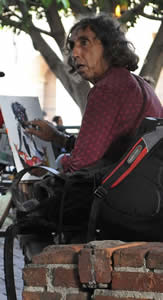
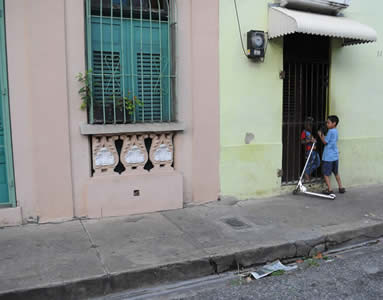
© 2015 Callyn Yorke
El Beaterio, Santo Domingo, DR 8 June 2015 Panteon de la Patria, Santo Domingo, DR 23 June 2015

© 2015 Merissa Mendez © 2015 Callyn Yorke
Historical marker on the Panteon, Colonial District, Santo Domingo, Dominican Republic 28 June 2015
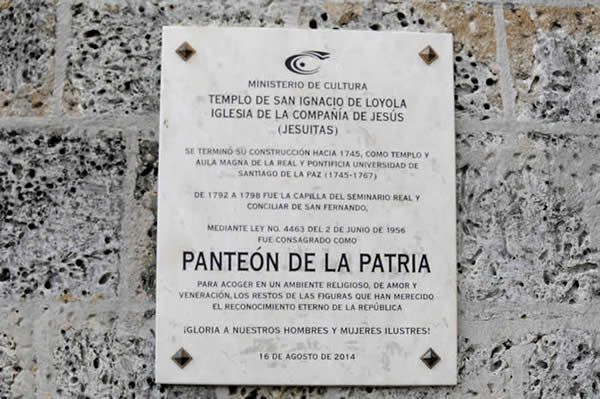
© 2015 Callyn Yorke
Fortaleza Ozama with walls of coralline fossils, overlooking Rio Ozama and the Port of Santo Domingo, DR. 27 June 2015
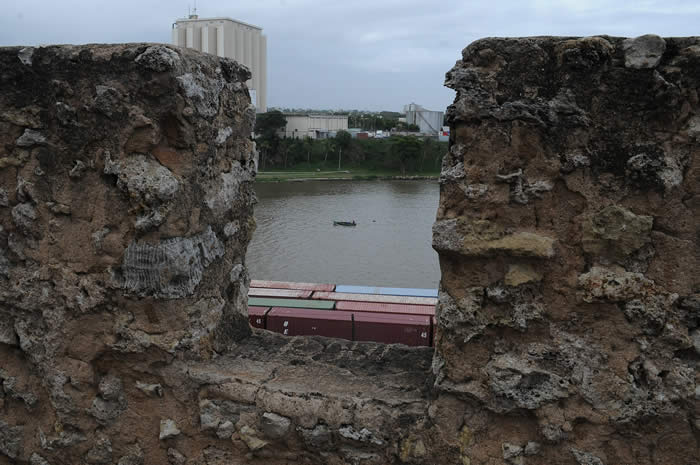
© 2015 Callyn Yorke
Close-up image of coralline fossil material commonly found in historic buildings of Santo Domingo, DR 27 June 2015

© 2015 Callyn Yorke
Indeed, the Colonial District of Santo Domingo has some of the best preserved churches, museums, fortresses and monuments found in the Caribbean. Those places were cool enough on a hot day, though my binocular was frequently focused on movement in the town squares and city parks. All of these had clusters of massive trees, many flowering and fruiting which attracted a wonderous variety of interesting birds. Within an hour of our arrival in Santo Domingo, I easily found several new species of bird, notably the much sought-after endemics such as Hispaniolan Parakeet and the enigmatic Palm Chat, the latter, appropriately designated as DR's national bird. Two other species of regional endemics (i.e. widespread in the Greater Antilles) were seen the next day in the Colonial District feeding their nestlings, apparently undisturbed by the noisy automobile and pedestrian traffic below them: Antillean Mango and Gray Kingbird.
Palm Chat (Dulus dominicus) Santo Domingo, DR 8 June 2015
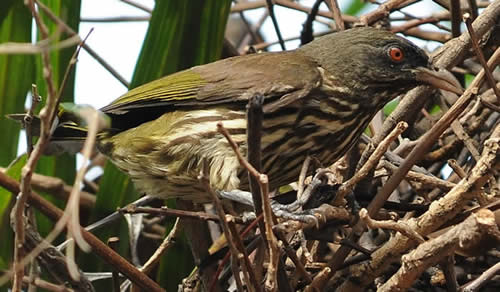
© 2015 Callyn Yorke
Antillean Mango (Antracothorax dominicus) Santo Domingo Gray Kingbird (Tyrannus dominicensis) Santo Domingo

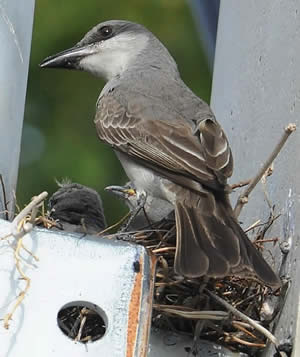
June 9, 2015 © 2015 Callyn Yorke June 9, 2015
Here's an annotated tourist street map showing the locations I found significant birdlife in Santo Domingo.
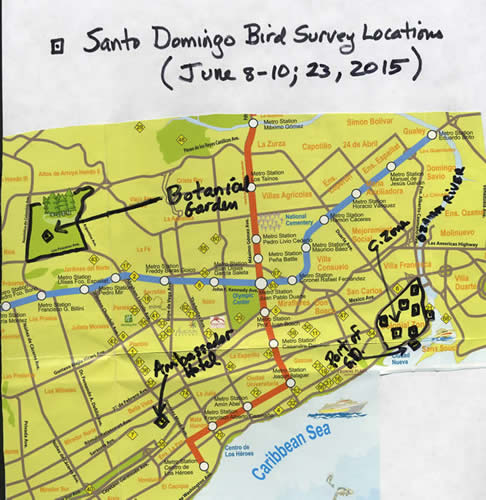
The National Botanical Garden of Santo Domingo was unquestionably the finest birding spot I found in the city. The place is huge, perhaps 120 acres, and provides food and cover for a surprising number of the region's specialty birds. Merissa and I spent about three hours one morning wandering on the paved and unpaved pathways, enjoying the shade and water features. Several species of lizard (mostly anoles) were evident, along with a few Hispaniolan endemic birds. Among the most conspicuous of the island's endemic birds was the Hispaniolan Woodpecker (photo). Although widespread and fairly common throughout the island, they were numerous, vocal and gregarious in the botanical gardens. Some were evidently nesting in palm trees with multiple cavities from previous years.
Hispaniolan Woodpecker (Melanerpes striatus) Botanical Gardens, Santo Domingo, DR
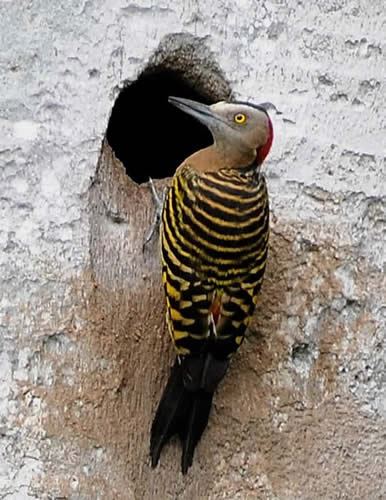
© 2015 Callyn Yorke
Ameiva chrysolaema consuming a small anole, Botanical Gardens, SD Anolis cybotes displaying on a rock, Botanical Gardens, SD

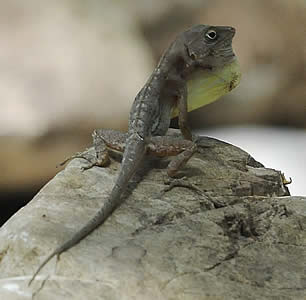
© 2015 Callyn Yorke
The author, Japanese Garden, Santo Domingo Botanical Gardens 9 June 2015

© 2015 Merissa Mendez
June 28, 2015
The morning before our flight from Santo Domingo back to the States, I took a cab to the Hotel Embajador (Ambassador Hotel) hoping to see the famous resident colony of the endemic Hispaniolan Parakeet. Although I had heard these birds and caught glimpses of them flying over the Colonial District, I was unable to get any photos of them. The best place to find these birds in Santo Domingo was reportedly the grounds of the old hotel near the intersection of Av. Mirador Sur and Av. Winston Churchill. The round-trip, Sunday morning cab fare was $25, which was about right, considering it was a couple of miles across town.
While waiting for the cab in front of our hotel in the Colonial District, I spotted a pair of Hispaniolan Parakeets in a neaby flowering tree. As I was preparing to photograph them, my cab driver arrived and began waving his arms and shouting something, indicating he wasn't going to wait all day. He seemed rather upset about something but knew where the Embajador was and agreed to take me there and back. This man was indeed troubled. He was suffering from a nasty upper respiratory infection that caused him to craw and spit out the window every thirty-seven seconds as we sped through town toward our destination. I sat in the back seat, diagonal from the driver and dodged most of the overspray from large projectiles of saliva and yellowish-brown mucus.
When we parked in front of the Hotel Embajador there were everywhere sounds of screeching parrots. I jumped out of the taxi, informing the nearly comatose driver I would be walking around here for about 15-20 minutes. He reclined the driver's seat and almost immediately appeared to fall into a deep sleep. The next fifteen minutes or so I kept busy following and photographing more Hispaniolan Parakeets than I could accurately count (perhaps 80-100). The noisy, gregarious birds were flying about and clamboring in the canopies of a variety of fruiting trees. Although the harsh morning lighting was poor for photography (digital cameras are overly sensitive to bright light) I was able to position myself with the sun coming in at right-angles for a few usable images. Hands down, this was the best place in Santo Domingo, and perhaps in the entire Dominican Republic, to observe and photograph this otherwise scarce species. Evidently, all of their nesting and food requirements were met on or near the hotel grounds, presumably due to a concentration of mature ornamental palms and other exotic fruiting trees. And, best of all, the hotel management is apparently cooperating with conservation organizations to preserve and protect these extraordinary birds, which might otherwise be considered a noisy nuisance.
Hispaniolan Parakeet (Psittacara chloroptera) Hotel Embajador, Santo Domingo, DR 28 June 2015

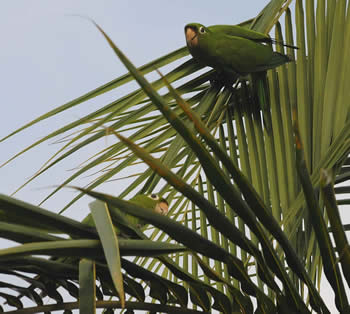
© 2015 Callyn Yorke
Aside from this morning's zombie apocalypse taxi ride through Santo Domingo, the Hispaniolan Parakeet show had been a fitting conclusion to my birding adventures in the DR. It was time to collect my notes and thoughts and prepare another scouting trip report for a Tropical Biology course. DR is certainly unique among tropical destinations and has much to offer in terms of natural history and scenic beauty. Questions remain, however regarding cost and logistics. Decent food and lodging in DR is relatively expensive, overland transportation to remote areas is problematic and natural history experts are few and far between. Additionally, there are safety concerns, particularly in the southwest near the Haitian border.
Yet, the country has extraordinary possibilites for naturalists willing to tolerate the relatively high costs of living, inconveniences and frequent adventure. I can't recall any other country where a high number of endemic birds were so easily found as in the DR. Further, even amateur naturalists may make significant contributions to botany and zoology in the DR. There are many opportunities for discovery here that await those with a keen eye and curious intellect. Information about the distribution and ecology of even the commonest species, e.g. Palm Chat, is largely lacking. Clearly, DR has real potential for a field course in Tropical Biology.
The author in DR, 20 June 2015
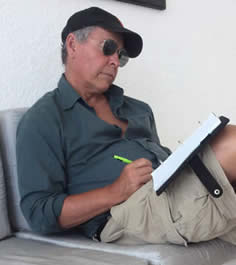
© 2015 Merissa Mendez